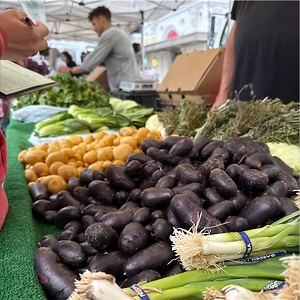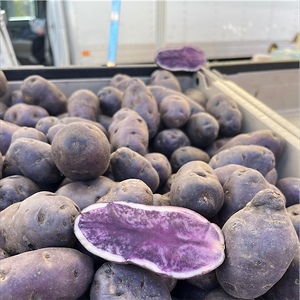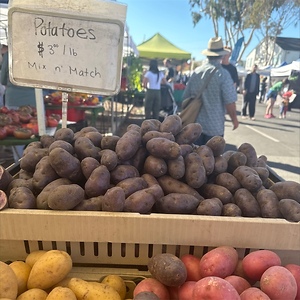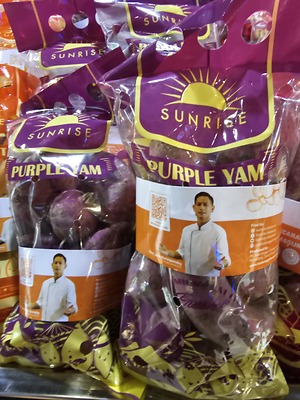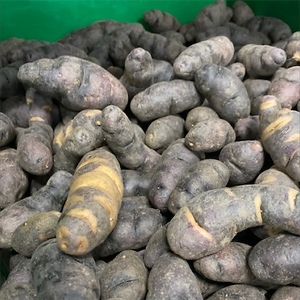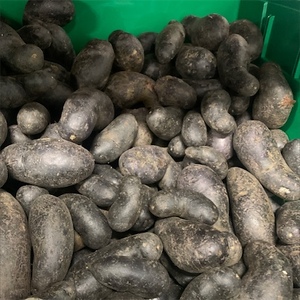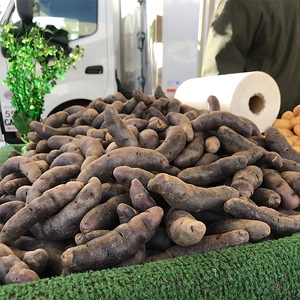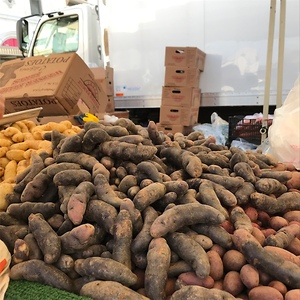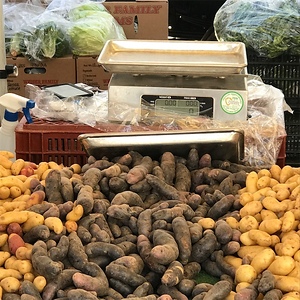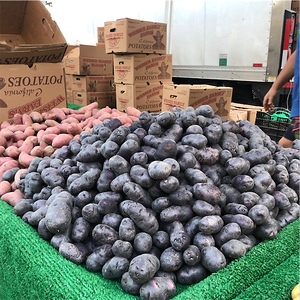

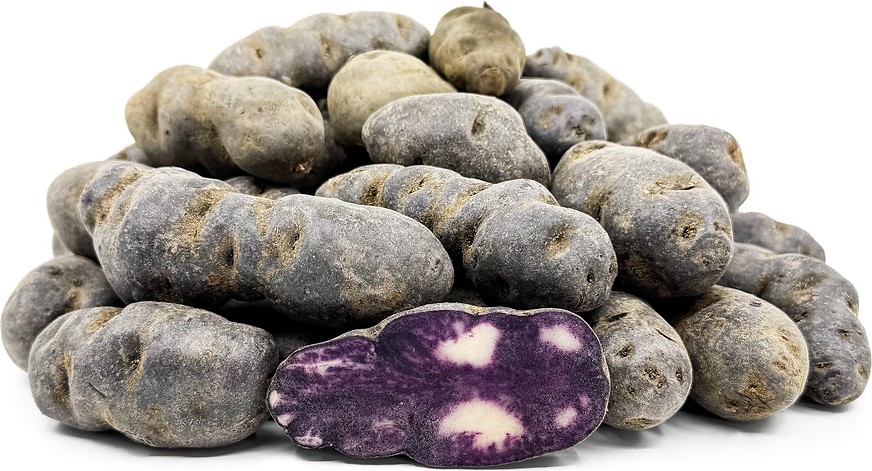
Purple Fingerling Potatoes
Estimated Inventory, 10 lbs : 0
Description/Taste
Purple Fingerling potatoes are small in size, ranging from 2 to 20 centimeters in length, depending on the variety, and have an elongated, slender, cylindrical to oblong shape with blunt, curved ends. Each tuber will vary in appearance, according to the variety’s typical traits, and most Purple Fingerling potatoes will showcase a straight to slightly curved shape. The tuber’s skin is taut, firm, and lightly textured, either smooth with shallow or lumpy with deep-set eyes. Some varieties may also have rough brown spots and markings scattered across the surface. Purple Fingerling potatoes appear in purple, purple-brown, and dark purple, almost black shades. Underneath the surface, the solid purple to variegated purple and white flesh is hard and slippery when raw. Once cooked, the flesh softens and develops a creamy to dry, slightly fluffy, tender consistency. Purple Fingerling potatoes are generally more waxy than starchy, creating a denser texture. The varieties are only edible after cooking and are known for their mild, subtly sweet, nutty, and earthy flavor.
Seasons/Availability
Purple Fingerling potatoes are available year-round.
Current Facts
Purple Fingerling potatoes, botanically classified as Solanum tuberosum, are a category of small, elongated tubers belonging to the Solanaceae or nightshade family. Several varieties are generally grouped under the Purple Fingerling name, including popular cultivars like Purple Fiesta, Purple Peruvian, Purple Majesty, Magic Molly, and Purple Pelisse. Chefs and home cooks favor Purple Fingerling potatoes for their unusual coloring, size, and flavor. The tubers acquired their fingerling name from their slender, slightly curved appearance, which was said to resemble a human finger. Purple Fingerling potatoes are easy to prepare and can be utilized in a wide array of savory culinary dishes. The tubers maintain a purple tint when cooking and are valued for their enhanced nutritional properties due to their pigmented nature. In modern markets, Purple Fingerling potatoes are still somewhat rare compared to white and red-skinned varieties, but they are increasing in notoriety and popularity as a specialty ingredient.
Nutritional Value
Purple Fingerling potatoes vary in nutritional content, depending on the specific variety. Purple potatoes, in general, are a source of fiber that regulates the digestive tract, and vitamins B6 and C strengthen the immune system and assist the body in producing energy. Purple potatoes also provide minerals like potassium, magnesium, iron, copper, phosphorus, manganese, and calcium. Potassium helps balance fluid levels and replenish electrolytes, while magnesium controls nerve functions. Iron develops the protein hemoglobin for oxygen transport through the bloodstream, copper helps build connective tissues, and calcium and phosphorus support healthy bones and teeth. The tubers colored nature indicates the presence of anthocyanins, natural pigments with antioxidant properties to reduce inflammation and guard the cells against the damage caused by free radicals.
Applications
Purple Fingerling potatoes have an earthy, nutty, and subtly sweet flavor suited for cooked preparations. One of the benefits of fingerling potatoes is that they do not need to be peeled before use and have thin skin. It is important to note that Purple Fingerling potatoes will lose a portion of their coloring during the cooking process, but some coloring will remain. Baking or roasting the tubers will help keep a more vibrant hue. When boiling, it is also recommended to add vinegar to the water to prevent color loss. Purple Fingerling potatoes hold their shape when cooked, adding a dense, creamy texture to dishes. The tubers can be cooked and tossed into potato salads, simmered into soups and stews, or sliced and added to gratins. Purple Fingerling potatoes can also be used to make colorful gnocchi, sliced and fried into chips, or used to make hashbrowns. Purple Fingerling potatoes are popularly smashed and cooked or roasted in restaurants as a simple side to seafood and other meats. Fingerling potatoes have a higher ratio of skin to flesh, allowing them to develop a crisper bite. Try adding Purple Fingerling potatoes to boiled celery root, garlic, and kohlrabi as an unusual, mashed potato dish. Purple Fingerling potatoes pair well with vegetables such as asparagus, broccoli, radishes, and mushrooms, aromatics like garlic, onions, and shallots, and herbs such as oregano, basil, chives, and thyme. Whole, unwashed potatoes will keep for several weeks when stored in a cool, dry, and dark location.
Ethnic/Cultural Info
NASA is evaluating purple potatoes and other varieties as potential crops for Mars cultivation. NASA and the International Potato Center, or CIP, in Lima, Peru, began a partnership in the early 21st century to conduct several studies testing potatoes in specific conditions. Potatoes were the first vegetables to be grown in space, and the tubers are high in carbohydrates, contributing to essential caloric needs. Potatoes are also relatively easy to grow, and many varieties have disease resistance, making them a hardy food source. During the CIP and NASA study, soil was gathered from the Atacama Desert in northern Chile to simulate the soil on Mars. The Atacama Desert is one of the driest places on Earth, and it is estimated that rain falls within the region once every ten years. The soil quality is similar to the desolate nature of Mars and is ideal for space studies. Over 700 kilograms of soil were transported to Lima, and potential potato varieties were selected from the 4,500 cultivars catalogued by the International Potato Center. The study consists of three phases, including a simulator where the plants are subjected to below-zero temperatures, intense air pressure, and high carbon monoxide concentrations to evoke the harsh conditions found on Mars. Scientists hope this experiment will lead to the discovery of potato varieties suitable for future cultivation and will give insight into cultivation outside of Earth’s atmosphere.
Geography/History
Purple Fingerling potatoes are descendants of potato varieties that arose in South America. Wild ancestors of potatoes have been naturally growing since ancient times, and the first domesticated potatoes were grown in the Andes Mountains around Lake Titicaca along the border of Peru and Bolivia. Potatoes were being grown before the Common Era and were a vital food source among indigenous South American populations. Later in the 16th century, the arrival of Spanish and Portuguese explorers contributed to the spread of potatoes. Spanish sailors carried potatoes on their voyage back to Europe and consumed the tubers to ward off scurvy. Potatoes were introduced to Spain around 1570 and later spread to other European countries, including France, England, Germany, Belgium, and Ireland. Potatoes were initially met with hesitation but were eventually adopted as a staple culinary ingredient. The tubers were also spread to the United States in the 17th century. Fingerling potatoes have been present since the beginning of domestication and were bred over time for their small, elongated size and coloring. Scientists believe some of the early domesticated forms had a similar shape to modern-day fingerlings, and new varieties appeared throughout history in Europe and later in the United States. Today, many varieties of Purple Fingerling potatoes are sold worldwide, and the tubers are primarily positioned as a specialty crop in fresh markets and through retailers and wholesalers. Purple Fingerling potatoes are also planted in home gardens.
Recipe Ideas
Recipes that include Purple Fingerling Potatoes. One
| Ciao Florentina |
|
Purple Potato Salad |
| Beth Dunham |
|
Leek, Potato & Fennel Soup |



